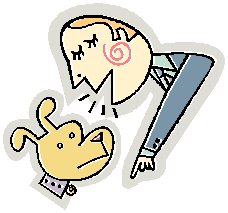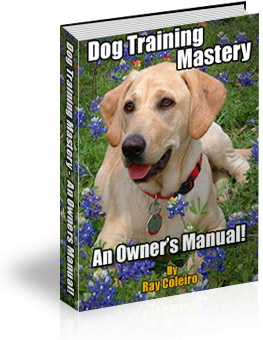SIGN UP NOW!
Do You Love
to Talk About
and Read About Dogs?
Then, you will want a subscription
to my FREE weekly ezine:
Dog Talk Weekly
Get over there, sign up, grab my free
report on the Myths & Mysteries of
Owning a Puppy. Enter the photo
contests every month.
And when you're done...
STOP BY MY NEW
DOG BLOG!
Read my fun posts about dogs.
Add your comments.
Baffled over getting and
raising a puppy?
Take my Puppy Parenting Course!
You'll learn everything from dog breeds and choosing one that's
right for you, to caring for a puppy through all its stages of growth,
and much more.
Puppy Tip!
Choosing a puppy for you or your family involves more than you might think.
It's about Personalities!
Did you know... that your puppy's personality will affect and even determine your training methods and how well you bond with your new puppy friend?
Want to know how to
figure out your puppy's personality?
I've just written the booklet, "Unveiling the Myths & Mysteries of Owning A Puppy" that explains exactly how to do that. I'm making it available as a complementary gift to fellow dog lovers like you.
Click here to
get your free gift!
(link opens in a new window) |

Dog Training Tips
Dog ObedienceTraining
Made
Easy
Are you having problems
training your dog?
Or are you just trying to figure it all out?
If so, here are some things you need to know.
Dog Obedience Training can be somewhat
complicated. As you know, the dog and the owner speak different languages.
It's up to us to figure out how to bridge that gap.
It's not unlike teaching a child. At first,
they don't understand the language either, but they quickly learn by
watching, listening and deducting. Like children, dogs take what we say
very specifically.
I'm reminded of those comedic 'aliens visit
earth' scenarios where they study our speech and interpret the meaning
exactly as the dictionary explains them. The sitcom,
"Third Rock From The Sun" is a perfect example. They often don't
understand the intricacies of the language, like words that sound the same
but have different meanings, or the slang usage most of us have become
accustomed to using. The result can be quite hilarious.
When training a dog, however, it's not
quite so funny when he or she gets the message wrong and just won't obey.
We might tend to think
the dog is 'disobedient', but that implies a conscious effort to disobey,
which often is not the case. If a dog disobeys, it's most likely for a
specific reason, like fear or a misunderstanding.
Mixed Messages
In training my own dogs, I'd often use
conflicting demands, not realizing what I'd said, until one day I was
watching one of those dog training shows. Suddenly, I realized my error
when I stepped outside and called my dog to stop some bad behavior.
"Kobe, Come here!" I yelled. After several
tries, I finally got his attention. When he arrived at my feet, my first
response was, "Bad dog. Why didn't you come?"
You can see the conflict here. For one
thing, I was calling him, but by scolding him when he arrived, I sent the
message that he was bad for coming to me. Notice that I used 'bad' and
'come' in the same command.
Training attempts such as this confuse the
dog and, in the end, lengthen or hinder the training process.
In another instance, I caught myself
instructing him thus: "Go get your toy, come on, go get your toy."
Obviously, this command is much too complicated for a dog to comprehend
and obey, especially since I'm telling him to 'come' and 'go' in the same
sentence. Often, these quirks of language are too subtle for us to notice,
but dogs certainly do.
You might be doing the same thing in your
dog obedience training efforts. It's quite common for dog owners to make mistakes
like this. In most of my 60 years, I've had a dog. You'd think after all
that experience I'd know better, but clearly I didn't. Even today, I catch
myself sending the dog double messages. When that happens, he just stands
there and looks at me, waiting for the correct command. A few sentences
later, I get it right.
Dogs make good teachers, it seems.
If you're having dog obedience training problems,
whether it's a new puppy or an older pet, it's not too late. They can be
trained at any age, despite the old saying, "you can't teach an old dog
new tricks." Fact of the matter is, you can. Quite successfully.
For more dog obedience training tips and
advice, click here to read the book review
______________________________
Dog Training Tips
How To Read Your Dog
DID YOU KNOW...
About Tail Wagging?
In my youth, I studied my dog a lot and
often found her facial expressions absolutely hilarious. My mother,
unfortunately, didn't see the humor.
Our cocker spaniel had a way of reshaping
her eyes so they were somewhat pointed at the top and rounded at the
bottom. To me, her quizzical expression meant she was wondering what game
I had up my sleeve.
Anyone who's spent time playing with their
dog will recognize the signs that he or she wants to play. A toy placed at
your feet, or a wagging tail are pretty good indications.
The common believe is that a wagging tail
means the dog is friendly and playful, but I've learned otherwise.
My current dog wags her tail a lot because
she is friendly and playful, but when she's intimidated by
strangers or loud noises, it hugs her behind and she presses up against my
legs for protection.
In this state, a dog could express the fear
by attacking as my other dog, Kobe, does.
He seldom wags his tail. He's more
aggressive, so it's usually tense and curled up in its natural position
over his back. I use different techniques to understand him, such as his
violent growling. I now know at what point he's actually angry enough to
bite, but growling is his way of communicating, even when he's pleased.
These are just some of the signs we use to
learn a dog's state of mind, but did you know that a wagging tail does not
always mean a dog is friendly or playful?
As a matter of fact, if a dog's tail is
high up and wagging, it could indicate aggression. Unfortunately, many
people don't understand this and approach such a dog, arm outstretched,
only to get bitten.
It's imperative that children learn how to
read a dog, even if they don't have one of their own. By understanding the
basics, being attacked is much less likely.
Did You
Know...
About Protecting Yourself?
One of the first things I learned as a
child was to never run from an aggressive dog. I was taught to freeze,
don't move, wait, and continue on only when it's safe to do so. I've never
been bitten by a strange dog, although several have shown aggression
toward me.
I'll never forget one incident when this
training worked fantastic. I was about 10 at the time, walking down the
sidewalk when a small dog came tearing off a verandah, barking as though
he'd rip my leg off.
He did scare me, I admit, but knowing what
to do helped me to stay calm and ward of an attack. I stopped in my tracks
and froze. To my surprise, he stopped too, just a few feet from me. He
continued barking for awhile, but soon slowed to intermittent barks. All
the while, I spoke quietly to him, calling him a good dog and that I
wasn't going to hurt him.
When I froze, he seemed confused and
probably wondered why I wasn't running. He just looked at me seemingly
confused, and barked.
It's important, at this stage, not to look or stare at the dog as this is
viewed as aggression. Eventually, he stopped barking and slowly headed
back to his porch. He kept turning and barking now and then, probably to
tell me to get out of there. He felt he'd done his job.
Slowly and cautiously, I began to take a
few steps. From his porch, he just watched and barked at me as I moved
past his house in a non-threatening way.
This move is extremely important for
everyone to understand.
Did You
Know...
About how
to react?
One time, while I was letting my dog run
loose at the park, a woman passed by carrying a rather large handbag on a
long strap. It was swaying gently beside her as she walked.
My dog began circling and closing in on
her. Ignoring my calls, he went after her bag, probably thinking it was
another animal on a leash. Instead of freezing or dropping the bag, she
began swirling the bag at my dog, making him increasingly aggressive. I
eventually got him under control and she moved on, unhurt, although I know
he scared her.
Thereafter, I always kept him on his leash,
thankful he didn't get the opportunity to bite her.
Running, kicking, swatting, waving or
throwing things or any other aggressive behavior will trigger a dog's
natural instincts. It's best to do as I did anytime a dog approaches,
aggressively or otherwise.
If a dog physically jumps up on you in an
attack, try to stay calm. As he jumps, bring your knee up as hard as you
can and hit him in the chest. This surprises the dog because he doesn't
see it coming. And because he doesn't know what hit him, it doesn't
trigger more aggression.
After he's down, go into the freeze mode
until he calms or retreats, or his owner controls him, and then slowly try
to move away.
For more tips and
advice, see this book review |
|
Dog Nuisance Behavior
Does your dog challenge you?
This 55-page manual will give you the answers to your dog's
nuisance behavior. Get more details on
positive dog training to
stop nuisance behavior. |

Secrets to Dog Training:
A comprehensive training package put together
by a professional dog
trainer.
His advice: get it right the first time
so you save time and effort training your new or adult dog. Works on all
breeds. Click above to
read the review.
Why it's important to
Get it Right

I just came across an instruction
book that teaches the right way to train a dog to get fast,
long-lasting and effective results.
If I'd had this book years ago, my life would have been
much less complicated and certainly less stressful. Having a dog that just
doesn't seem to want to obey, who reverts to old behavior at the drop of a
hat, can make life with a dog barely worth the trouble.
If you train your dog correctly in the
beginning, regression to old habits are minimized and the actual training
time can be cut significantly.
When I was a kid, we had an exceptionally well-trained
cocker spaniel. Her replacement was nothing like
our Jeannie, who was very intelligent and quick. The newcomer was far more playful and like an overactive child,
she didn't seem to
have the 'patience' to sit still long enough to learn anything. After
several months, the dog went back to the seller.
This happens frequently when families find that trying
to train their dog seems too difficult. They think it's taking
too long or that the dog is untrainable. Just when they think they're
making headway, the dog reverts to old behavior and seems to forget
everything he or she had learned.
I've discovered an excellent training manual that
certainly has taught me a few things.
Written by a professional dog trainer, this dog
obedience training book, Sit Stay Fetch, covers everything you'll ever want
to know about training your dog, young or old. Unlike many other manuals, this one
includes photographs of the steps you need to take to perform each
training exercise. It also covers other things you need to know, from
feeding to choosing a veterinarian.
And if you still have problems after following the steps in the manual,
you can contact the author directly for feedback
on your specific issue..
The Sit Stay Fetch package also includes several other useful manuals
on specific topics related to dog ownership.
Click Here
To read the full review.
_________

Dog Whispering

One of the Internet's best-selling
Dog Training eBooks

Discover the nutritional secrets that
can make the difference in your dog's overall health.
My
Healthy Dog Nutrition Secrets package explains all about the dangers
certain foods pose for your dog, includes delicious home- made dog food
recipes, dog care advice, puppy training and more.
Click for details.
|
